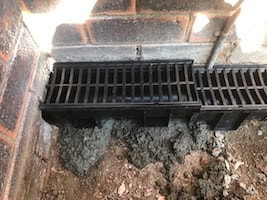
When you’re renovating or carrying out repairs on an older home, especially those built between the 1930s and 70s, it’s important to be aware of the construction materials and the possibility that products containing asbestos were used in the original build.
We’ll cover some of the places it’s found in older homes and buidlings and the ongoing danger asbestos presents. We’ll also cover why this product became so popular in building materials during this period. And as this is such an important topic requiring specialized knowledge, we have links to additional resources at the end of this post so you can research this topic further before starting your project.
If you suspect asbestos, don’t attempt any DIY work. If you’ve started, STOP immediately. Isolate the area keeping everyone, including yourself and pets, away from the area Call in licensed, trained professionals to assess and have the product safely removed from the home before undertaking work.
A reminder: Make sure you are aware of building products where asbestos materials were used and the dangers.
Why was Asbestos used in building materials?
The product was known for its durability, heat resistance, and insulating properties which made it a popular choice for use in construction during that era before the dangers became known.
It was used in wall and ceiling sheeting as well as spray-on ceiling products, particularly in areas prone to moisture like bathrooms, kitchens, and laundry rooms. It was often used in glues and adhesives like plaster and joint compounds, caulking and adhesives, and also textured paints.
Some of the products which used asbestos:
Insulation materials (such as attic insulation, wall insulation, and pipe insulation)
Ceiling tiles
Floor tiles and adhesive
Roofing and siding
Soundproofing
Textured paint and patching compounds like plaster and textured paint
HVAC duct insulation
Vermiculite insulation
Electrical wiring insulation
Fireproof gloves and stove-top pads
Ironing board covers
Asbestos curtains
Wallpaper manufactured before the 1980’s, especially with a vinyl finish
Drywall
Electrical panel housing
Products used with woodburning stoves, furnaces or coal stoves – eg surrounding wall insulation
Decorative elements in gas fireplaces, eg fake embers.
This list is not exhaustive. Find further possible exposure sites within resources linked at the bottom of this post and on this link to Mesothelioma.com
Why is Asbestos dangerous?
Asbestos is a fibrous material. If the product containing asbestos is disturbed it becomes hazardous. For example, if a ceiling containing asbestos is cut, sanded, drilled, or damaged in any way, the fibers are released into the air.
These tiny fibers, although they are invisible to the naked eye, pose serious health risks if inhaled. The fibers can also attach themselves to clothing, presenting ongoing dangers for others as they are spread away from the work site. For more detailed information, refer to asbestos.com for exposure risks.
During the 1970s, the risks to our health were increasingly being recognized. An awareness of the danger and toxicity of asbestos was growing. However its use in some products continued until the mid-1980s. Now, thankfully, many countries have banned the use of asbestos or have heavily regulated the use of asbestos products.
Homes built before 1980 are at a higher risk of containing asbestos in their building materials compared to newer builds.
This link to the Homeowner’s Guide to Asbestos is a helpful read with a list of common places asbestos is found in homes and buildings.


